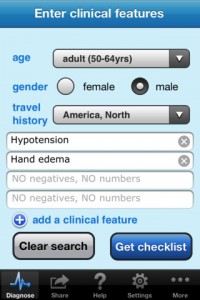 In building its first-ever native iPhone app, diagnostic decision support content provider Isabel Healthcare also seized the opportunity to improve its flagship Web-based product.
In building its first-ever native iPhone app, diagnostic decision support content provider Isabel Healthcare also seized the opportunity to improve its flagship Web-based product.
"When you design something for an iPhone specifically, it forces you to simplify things," CEO and co-founder Jason Maude explains. Most notably, the app has to support input on a touchscreen rather than with a mouse and keyboard. "I'm a great believer in simplification," Maude adds.
The company, which is based outside of London and has a U.S. headquarters in Ann Arbor, Mich., on Monday released both its inaugural iPhone app and a new version of its desktop software. The main point of [building a native app] that was to make Isabel more accessible," Maude tells MobiHealthNews.
The initial response has been positive. Maude reports that the Isabel app had received 11 five-star ratings in the UK iTunes site as of Monday afternoon and was the top-grossing medical app in the UK for the day. In the US, the app was No. 7 in terms of revenue on Monday evening.
Maude says the company sold a few hundred subscriptions without really publicizing the app before this week, and he has been pleasantly surprised at the number of long-term subscribers. Isabel offers a weekly subscription for $2.99, a monthly option for $10.99 or a yearly subscription for $119.99. "I thought most people would take weekly, but a lot are taking monthly or annual subscriptions," Maude says.
An annual subscription to the Web product costs $250-$375, and discounts are available for site licenses. However, the iPhone app fee does not include a subscription to the standard Web-based system because Apple would not let Isabel bundle its products. Current subscribers can still access a version of the Web product that is been optimized for smartphones.
As with the Web database, users of the iPhone app enter the patient's age and gender, along with clinical observations – for example, "dull pain in the left arm" or test results – and the Isabel system returns a list of possible diagnoses. "Isabel does not tell you that diagnosis. It only gives you some possibilities," Maude says.
In version 1.0, users can click on icons for MedlinePlus, PubMed and Wikipedia to get more information on each suggested diagnosis. "In the next release, we want to offer native app-to-native app linking," Maude says, bringing the mobile app closer to the Web product, which can be integrated with several major EHR systems.
Maude also would like to explore the possibility of adding predictive text entry and speech recognition in future updates.
Maude says to expect Isabel to optimize the app for the iPad before developing a product for the Android platform. "Android is in our plans, but physicians have iPhones," he notes.
Isabel also is working on a consumer version of its medical database.

















